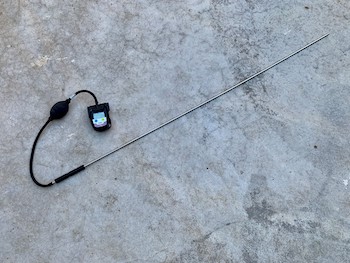Recent reports indicate an increasing number of trucks are being rejected at delivery for excess phosphine. The rejections fall into one of two categories: high-level phosphine, where phosphine has been misapplied and put people in danger, and low-level phosphine, where the grower’s fumigation practices need tweaking to vent gas to a lower level.
Attempted fumigations just prior to, or even during, transport are thought to be the leading cause of the high phosphine readings at delivery sites. Misuse of phosphine, including any off-label practices, places operators, truck drivers, delivery site staff and, potentially, the general public in danger. Perpetrators in this category can expect to deal with the authorities and the consequences, which often involve quarantining the truck for several days until the load is vented to a safe level for off-loading.
Low-level phosphine rejections are the ones on the rise, according to the bulk handler, and there are a few contributing factors:
- The bulk handler has introduced phosphine detection probes requiring a clearance reading of less than 0.3 parts per million (ppm), measured via a grain spear sample.
- The bulk handler mandates all grain delivered after February be fumigated.
- Venting phosphine to 0.3ppm can take longer than the label directs in some cases.
Research required
Testing for phosphine residue at delivery ensures operators are not exposed to harmful levels of the gas while handling the grain. Confusion on what is a safe clearance level for phosphine has led the bulk handler to use a limit of 0.3ppm taken via a grain spear sample.
The safety limit of 0.3ppm is supposed to be measured via the time-weighted average in the enclosure and work area, not the grain bulk itself as the bulk handler is doing. Further research is required to develop a sampling method and gas limit to ensure operator safety, without unnecessarily penalising operators with small amounts of residual gas that does not pose a health and safety risk.
Gas concentrations found within a grain stack are significantly higher compared to the surface of the stack, let alone the air around it that operators are breathing.
Label directions
Following a fumigation with phosphine, the label directs venting either with aeration fans operated for two hours on and two hours off for not less than one day, or not less than five days without fans. Research has found that this venting period may not remove gas levels below 0.3ppm when sampled with a grain spear, so if a bulk handler is requiring this clearance level, a phosphine meter is the surest way to know when venting is complete.
Phosphine meters
It is worth noting that most phosphine meters are designed to measure either high range for fumigation gas levels or low range for clearance or safety. When purchasing a phosphine meter for checking venting progress, ensure the measuring resolution is accurate at low range to measure 0.3ppm.
There are multiple sources of phosphine meters in Australia; what’s important is checking the supplier guarantees quality and accuracy for low level readings. Two well-known suppliers in the eastern states are Canary Company, which sells the Silo Safe, and Graintec Scientific, which sells the Drager Pac 7000.
Handy optional extras with phosphine meters include a cradle for the Drager models to connect to a gas line or spear, the spear itself and pumps, either external or built-in to draw the gas to the meter.
 A low-level phosphine meter is the surest way to know if grain has been adequately vented to the delivery requirements. Photo: Chris Warrick
A low-level phosphine meter is the surest way to know if grain has been adequately vented to the delivery requirements. Photo: Chris Warrick
For reliable clearance measurements, turn aeration fans off for at least 12 hours and take readings before out-loading grain from the storage.
Research has found that phosphine venting can take longer if the exposure period was extended, if the grain temperature was cold, or if the storage bulk was large (a flat-bottom silo greater than 1000 tonnes).
To ensure control of all life stages of insect pests, fumigation exposure periods must be long enough to allow the insects to continue developing to an active life stage to take up the gas; over 25°C takes seven days; between 15 to 25°C takes 10 days. Some operators choose to extend the fumigation exposure period to ensure gas concentrations reach the required 360ppm in all areas of the storage for the full seven to 10 days. What must be understood is that extending the exposure period allows more time for the grain to absorb the gas and, therefore, will also take longer to desorb during venting.
Cold grain has also been found to desorb phosphine slower than warm grain, so storages that have been under aeration cooling may take longer to vent below 0.3ppm than the one day directed by the label.
For obvious reasons, large storages can also take longer to vent given the distance gas has to travel through the grain before escaping.
Fumigation in grain bags has been proven possible. Phosphine is inserted into pipes placed every seven metres along the sealed bag for 10 days. However, venting can be the most challenging component to this fumigation process.
A large-capacity fan can be connected to the starting end of the bag and, with the other end of the bag propped open, gas can be sucked out in two or more days. If power is not available, recent research has found that passive venting is possible using 50-millimetre fumigation pipes, where the phosphine can be removed and caps left off – but expect it to take two weeks or more to vent below 0.3ppm.
More information: Stored Grain, info@storedgrain.com.au, 1800 WEEVIL (1800 933 845).

























































